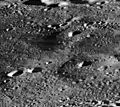
Olympus Mons is a large shield volcano on Mars. The volcano has a height of over 21.9 km as measured by the Mars Orbiter Laser Altimeter (MOLA). Olympus Mons is about two and a half times Mount Everest's height above sea level. It is one of the largest volcanoes, the tallest planetary mountain, and approximately tied with Rheasilvia as the tallest mountain currently discovered in the Solar System. It is associated with the Tharsis Montes, a large volcanic region on Mars.
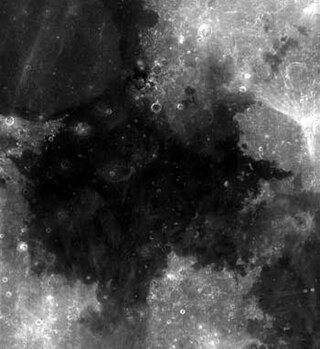
Mare Tranquillitatis is a lunar mare that sits within the Tranquillitatis basin on the Moon. It is the first location on another celestial body to be visited by humans.
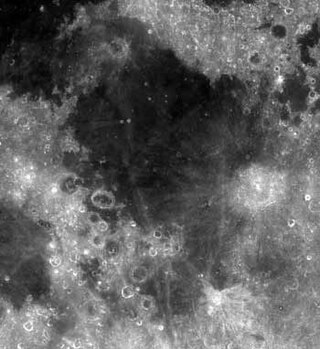
Mare Fecunditatis is a lunar mare in the eastern half of the visible Moon. The mare has a maximum diameter of 840 km.

Mare Marginis is a lunar mare that lies on the very edge of the lunar nearside. The selenographic coordinates of this feature are 13.3° N, 86.1° E, and the diameter is 358 km. The name is Latin for "Sea of the Edge".

Mare Nectaris is a small lunar mare or sea located south of Mare Tranquillitatis southwest of Mare Fecunditatis, on the near side of the moon. Montes Pyrenaeus borders the mare to the east and Sinus Asperitatis fuses to its northwestern edge. It is 84,000 square kilometers in size.

Mare Smythii is a lunar mare located along the equator on the easternmost edge of the Moon's near side. It is named for the 19th-century British astronomer William Henry Smyth. The Smythii basin where the mare is located is of the Pre-Nectarian epoch, while the surrounding features are of the Nectarian system. It is contained within a minimal diameter of 373.97 km, and has been excavated to a depth of 4 km. The mare material, which makes up the floor of the mare, is a low alumina basalt, and consists of Upper Imbrian basalt covered by Eratosthenian basalt. Features observed within the basin include wrinkle ridges, submerged "ghost" craters, domes, crater chains, and rilles.

Ascraeus Mons is a large shield volcano located in the Tharsis region of the planet Mars. It is the northernmost and tallest of three shield volcanoes collectively known as the Tharsis Montes.

Rille is typically used to describe any of the long, narrow depressions in the surface of the Moon that resemble channels. The Latin term is rima, plural rimae. Typically, a rille can be several kilometers wide and hundreds of kilometers in length. However, the term has also been used loosely to describe similar structures on a number of planets in the Solar System, including Mars, Venus, and on a number of moons. All bear a structural resemblance to each other.

Petavius is a large lunar impact crater located to the southeast of the Mare Fecunditatis, near the southeastern lunar limb. Attached to the northwest rim is the smaller crater Wrottesley. To the southeast are Palitzsch, Vallis Palitzsch, and Hase. Farther to the north is the large crater Vendelinus. Petavius appears oblong when viewed from the Earth due to foreshortening. Petavius is Imbrian in age.

Cauchy is a small lunar impact crater on the eastern Mare Tranquillitatis. It was named after French mathematician Augustin-Louis Cauchy. It is circular and symmetric, with a small interior floor at the midpoint of the sloping inner walls. Due to the high albedo of this bowl-shaped formation, it is particularly prominent at full Moon.

Arago is a lunar impact crater located in the western part of the Mare Tranquillitatis. It was named after French astronomer François Arago in 1935. Its diameter is 26 km. To the southwest lies the crater Manners, and beyond are Dionysius and the Ritter–Sabine crater pair. To the southeast is the large Lamont formation that has been submerged by the mare.

Alba Mons is a volcano located in the northern Tharsis region of the planet Mars. It is the biggest volcano on Mars in terms of surface area, with volcanic flow fields that extend for at least 1,350 km (840 mi) from its summit. Although the volcano has a span comparable to that of the United States, it reaches an elevation of only 6.8 km (22,000 ft) at its highest point. This is about one-third the height of Olympus Mons, the tallest volcano on the planet. The flanks of Alba Mons have very gentle slopes. The average slope along the volcano's northern flank is 0.5°, which is over five times lower than the slopes on the other large Tharsis volcanoes. In broad profile, Alba Mons resembles a vast but barely raised welt on the planet's surface. It is a unique volcanic structure with no counterpart on Earth or elsewhere on Mars.

Lawrence is a lunar impact crater that is located on a section of terrain to the east of Mare Tranquillitatis and northwest of Mare Fecunditatis. It was named after American physicist and Nobel laureate Ernest Lawrence and American astronaut Robert Henry Lawrence, Jr. To the southeast is the larger crater Taruntius. The rille designated Rima Cauchy crosses the eastern part of the Mare Tranquillitatis and reaches as far as the northern rim of Lawrence.

Ibn Battuta is a small lunar impact crater on the Mare Fecunditatis, a lunar mare in the eastern part of the Moon's near side. It lies to the southwest of the crater Lindbergh, and northeast of the prominent Goclenius.

Mons Gruithuisen Gamma (γ) is a lunar dome that lies to the north of the crater Gruithuisen at the western edge of the Mare Imbrium.
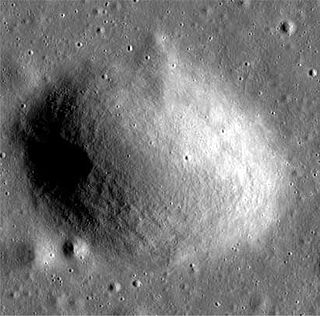
Donna is a tiny lunar crater on the near side of the Moon. Its name is an Italian female given name, and does not refer to a specific person. It is located in the eastern half of the Mare Tranquillitatis, at the summit of the lunar dome Omega (ω) Cauchy. As such domes are thought to be volcanic in nature, it appears likely that this crater was created by an eruption. This is in contrast to most lunar craters, which are now believed to be created by impacts. This crater is sufficiently small that it requires a large telescope to resolve.
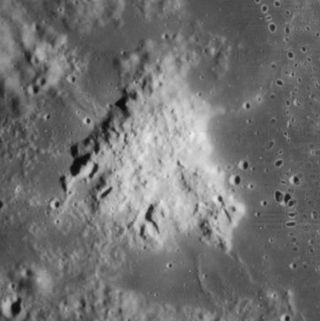
Mons Hansteen is a mountain on the Moon, also known as Hansteen Alpha (α), named after Christopher Hansteen. It is roughly triangular in shape and occupies an area about 30 km across on the western margin of Oceanus Procellarum, southeast of the crater Hansteen and north of the dark-floored crater Billy. It is thought to be an extrusion of volcanic material that is younger than the crater Hansteen, with most of surface volcanic ash been deposited 3.5-3.74 billion years ago.

The geology of the Moon is quite different from that of Earth. The Moon lacks a true atmosphere, and the absence of free oxygen and water eliminates erosion due to weather. Instead, the surface is eroded much more slowly through bombardment of the lunar surface by micrometeorites. It does not have any known form of plate tectonics, it has a lower gravity, and because of its small size, it cooled faster. In addition to impacts, the geomorphology of the lunar surface has been shaped by volcanism, which is now thought to have ended less than 50 million years ago. The Moon is a differentiated body, with a crust, mantle, and core.

Hadley–Apennine is a region on the near side of Earth's Moon that served as the landing site for the American Apollo 15 mission, the fourth manned landing on the Moon and the first of the "J-missions", in July 1971. The site is located on the eastern edge of Mare Imbrium on a lava plain known as Palus Putredinis. Hadley–Apennine is bordered by the Montes Apenninus, a mountain range, and Hadley Rille, a meandering channel, on the east and west, respectively.

Volcanism on the Moon is represented by the presence of volcanoes, pyroclastic deposits and vast lava plains on the lunar surface. The volcanoes are typically in the form of small domes and cones that form large volcanic complexes and isolated edifices. Calderas, large-scale collapse features generally formed late in a volcanic eruptive episode, are exceptionally rare on the Moon. Lunar pyroclastic deposits are the result of lava fountain eruptions from volatile-laden basaltic magmas rapidly ascending from deep mantle sources and erupting as a spray of magma, forming tiny glass beads. However, pyroclastic deposits formed by less common non-basaltic explosive eruptions are also thought to exist on the Moon. Lunar lava plains cover large swaths of the Moon's surface and consist mainly of voluminous basaltic flows. They contain a number of volcanic features related to the cooling of lava, including lava tubes, rilles and wrinkle ridges.





